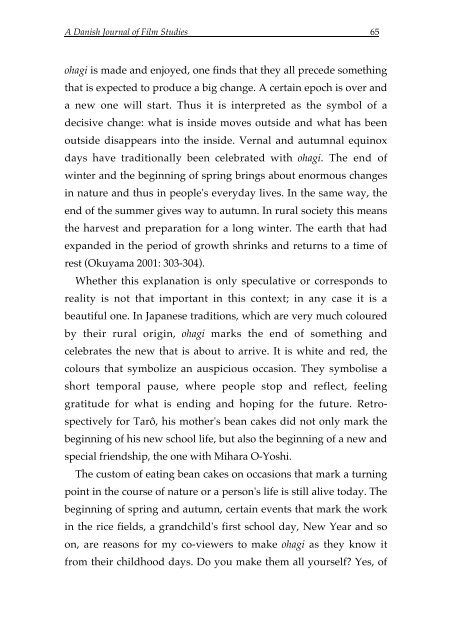The Face of Time - POV - Aarhus Universitet
The Face of Time - POV - Aarhus Universitet
The Face of Time - POV - Aarhus Universitet
You also want an ePaper? Increase the reach of your titles
YUMPU automatically turns print PDFs into web optimized ePapers that Google loves.
A Danish Journal <strong>of</strong> Film Studies 65<br />
ohagi is made and enjoyed, one finds that they all precede something<br />
that is expected to produce a big change. A certain epoch is over and<br />
a new one will start. Thus it is interpreted as the symbol <strong>of</strong> a<br />
decisive change: what is inside moves outside and what has been<br />
outside disappears into the inside. Vernal and autumnal equinox<br />
days have traditionally been celebrated with ohagi. <strong>The</strong> end <strong>of</strong><br />
winter and the beginning <strong>of</strong> spring brings about enormous changes<br />
in nature and thus in people's everyday lives. In the same way, the<br />
end <strong>of</strong> the summer gives way to autumn. In rural society this means<br />
the harvest and preparation for a long winter. <strong>The</strong> earth that had<br />
expanded in the period <strong>of</strong> growth shrinks and returns to a time <strong>of</strong><br />
rest (Okuyama 2001: 303-304).<br />
Whether this explanation is only speculative or corresponds to<br />
reality is not that important in this context; in any case it is a<br />
beautiful one. In Japanese traditions, which are very much coloured<br />
by their rural origin, ohagi marks the end <strong>of</strong> something and<br />
celebrates the new that is about to arrive. It is white and red, the<br />
colours that symbolize an auspicious occasion. <strong>The</strong>y symbolise a<br />
short temporal pause, where people stop and reflect, feeling<br />
gratitude for what is ending and hoping for the future. Retrospectively<br />
for Tarô, his mother's bean cakes did not only mark the<br />
beginning <strong>of</strong> his new school life, but also the beginning <strong>of</strong> a new and<br />
special friendship, the one with Mihara O-Yoshi.<br />
<strong>The</strong> custom <strong>of</strong> eating bean cakes on occasions that mark a turning<br />
point in the course <strong>of</strong> nature or a person's life is still alive today. <strong>The</strong><br />
beginning <strong>of</strong> spring and autumn, certain events that mark the work<br />
in the rice fields, a grandchild's first school day, New Year and so<br />
on, are reasons for my co-viewers to make ohagi as they know it<br />
from their childhood days. Do you make them all yourself? Yes, <strong>of</strong>














